Environmental Engineer Resume Examples

Mar 25, 2025
|
12 min read
Dig into crafting an outstanding environmental engineer resume that showcases your skills and eco-friendly achievements. Learn how to plant the seeds for future job success with practical tips tailored to your unique expertise in the environmental field.
Rated by 348 people
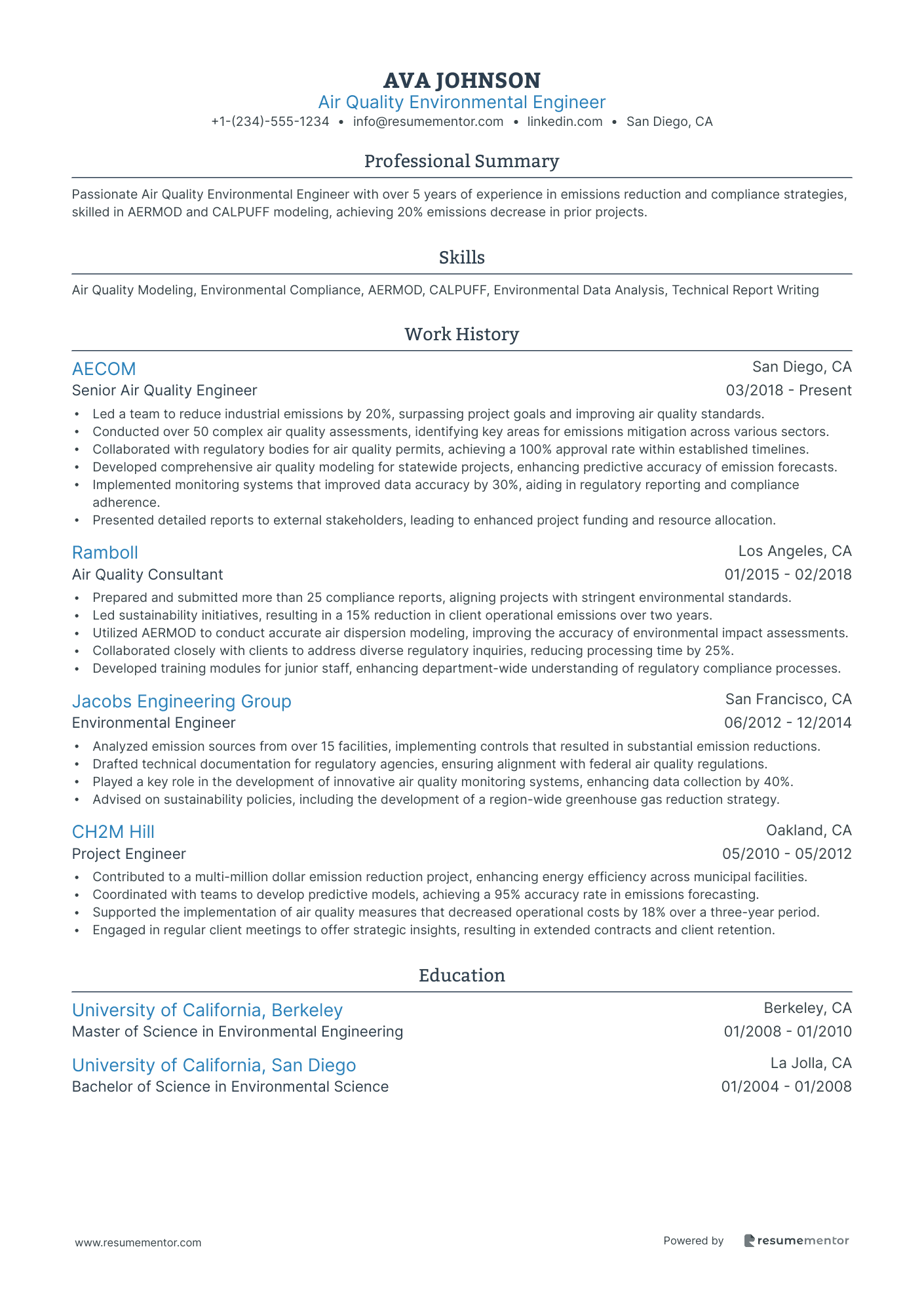
Air Quality Environmental Engineer
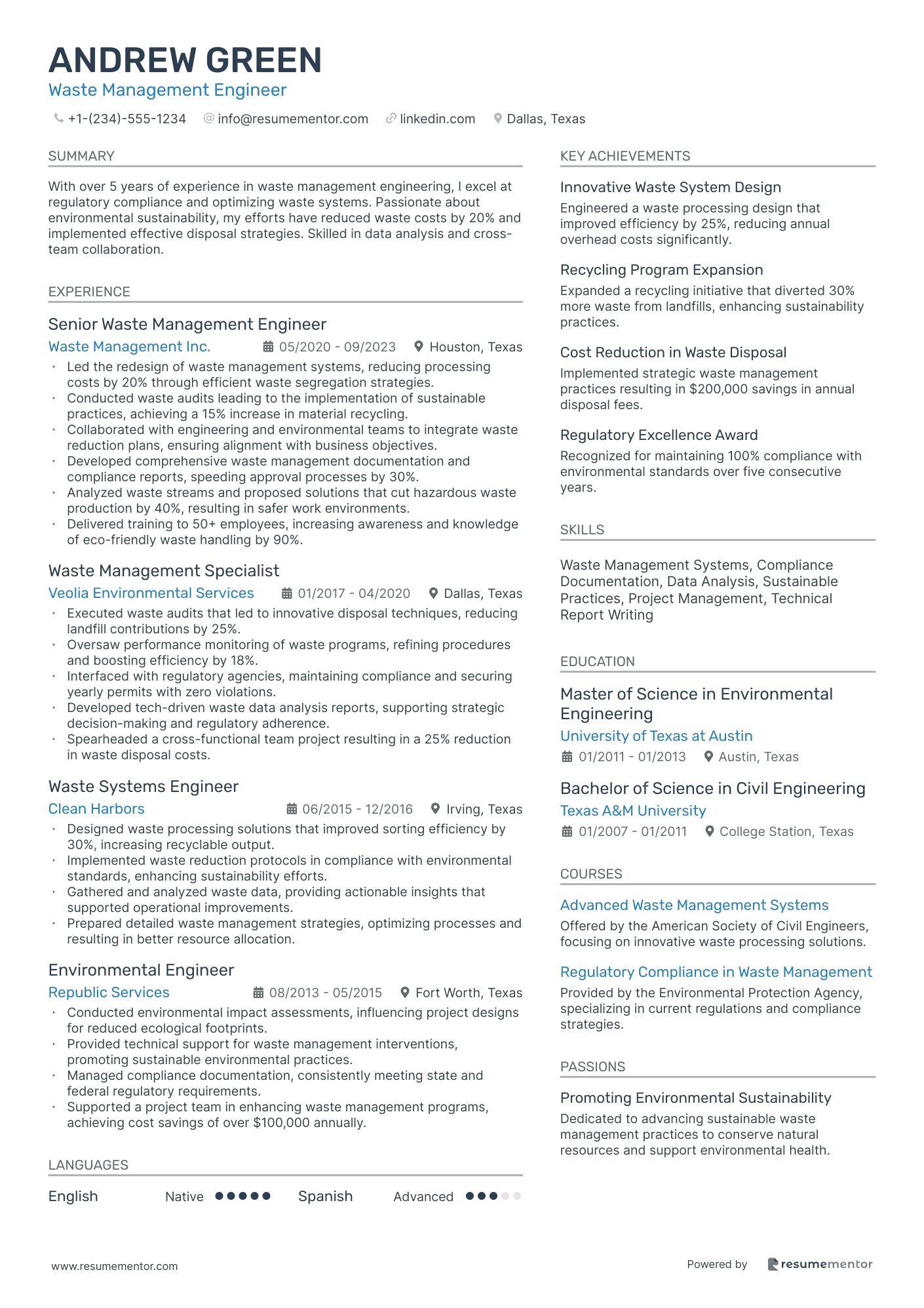
Waste Management Engineer
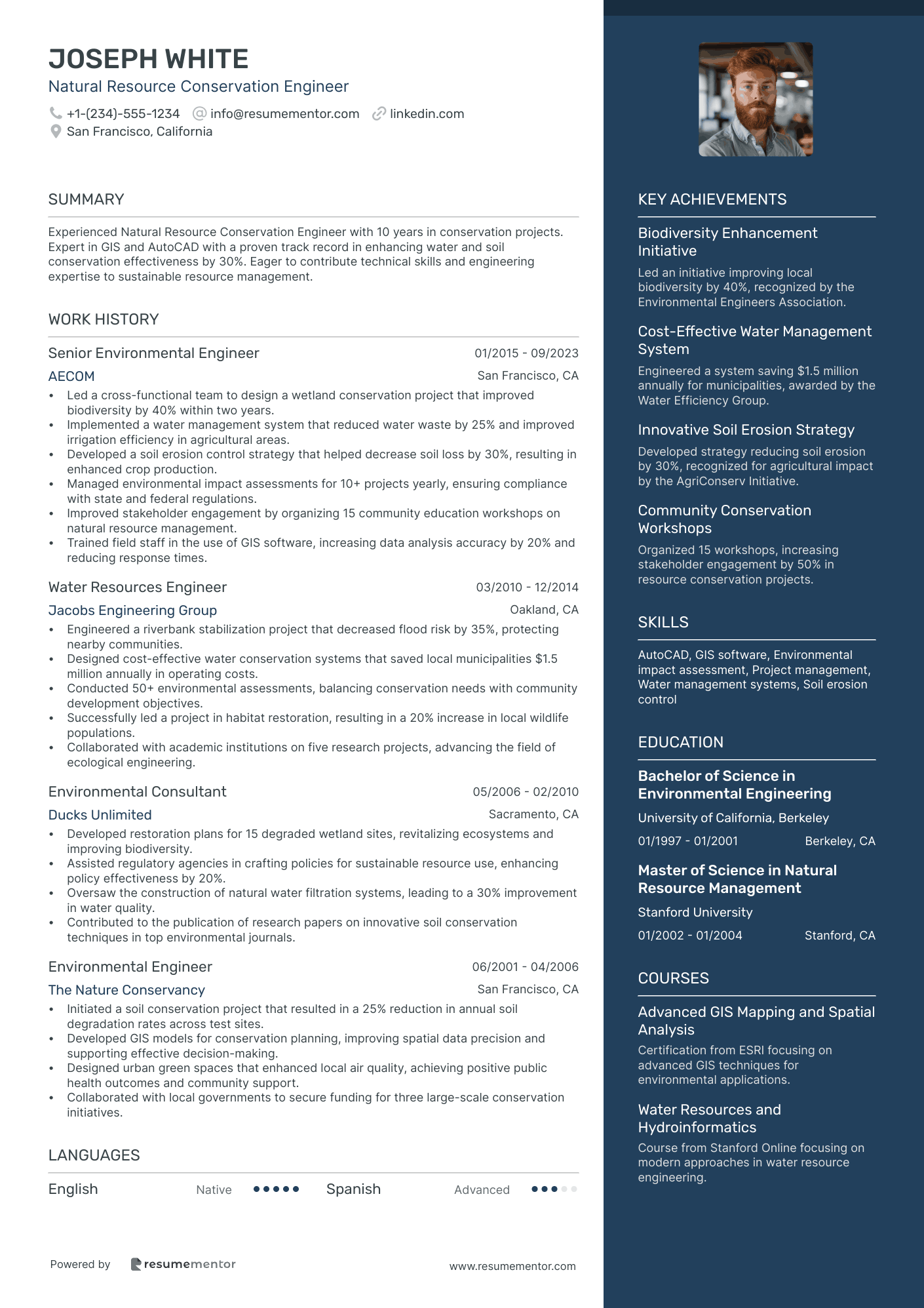
Natural Resource Conservation Engineer
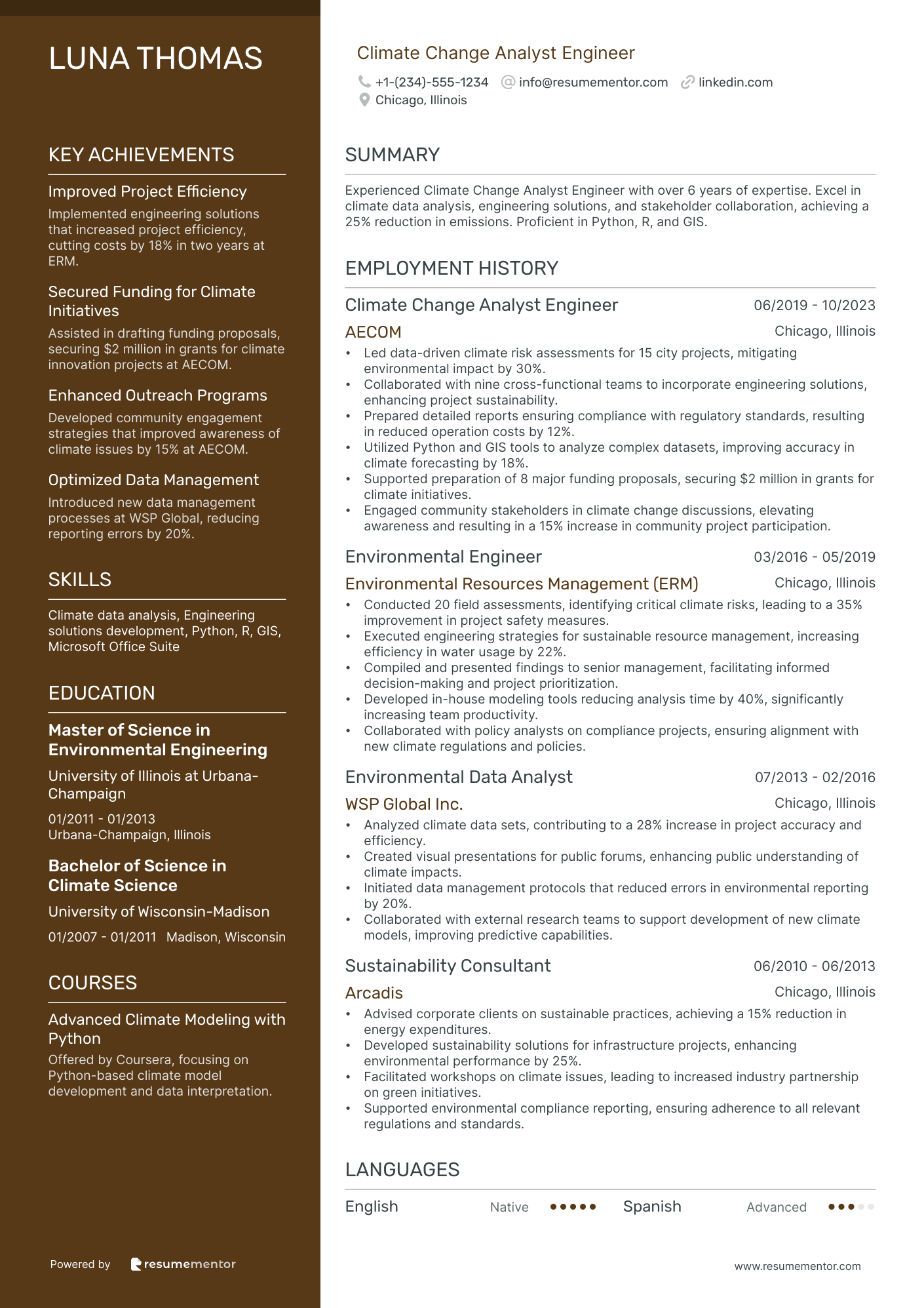
Climate Change Analyst Engineer
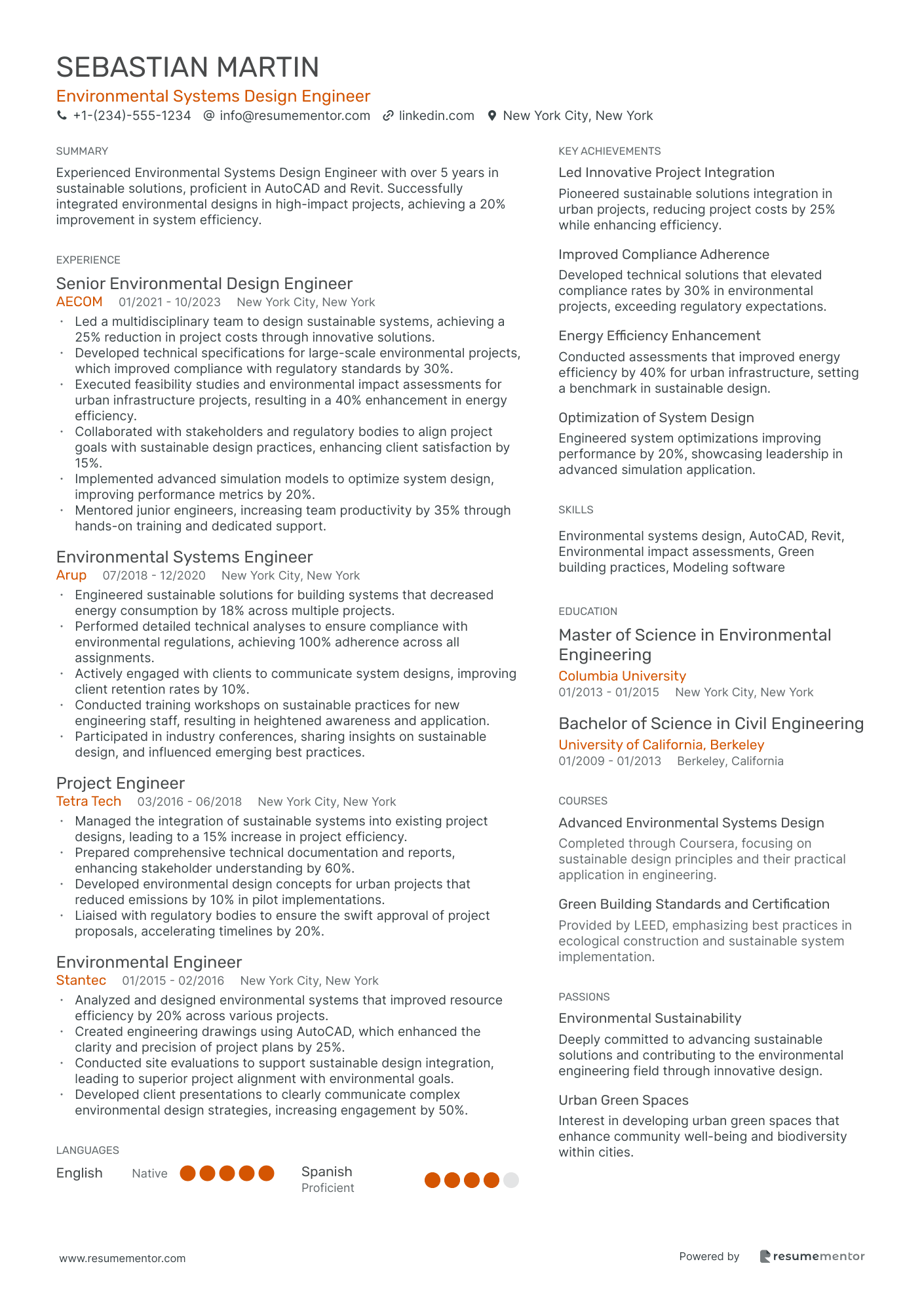
Environmental Systems Design Engineer
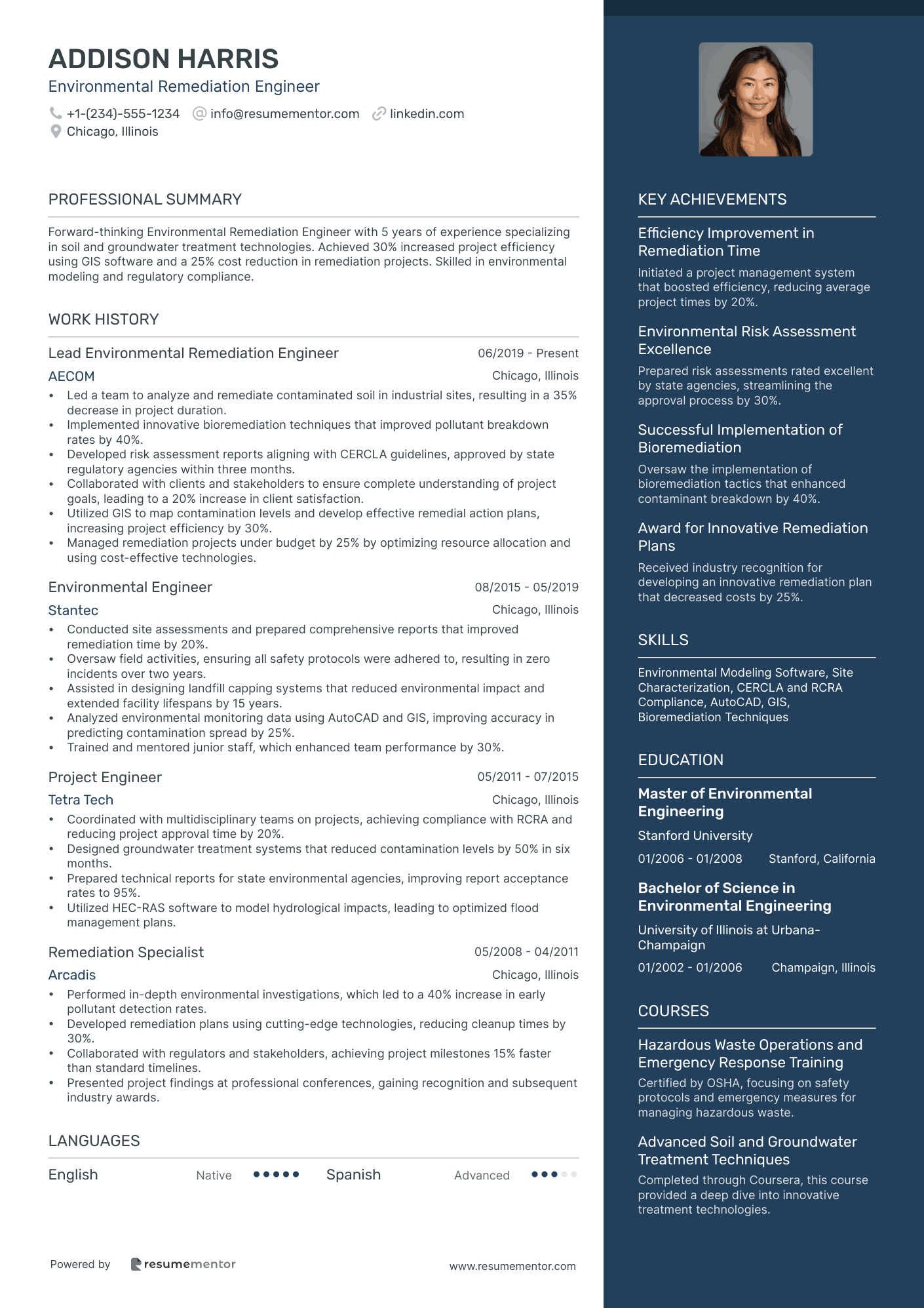
Environmental Remediation Engineer
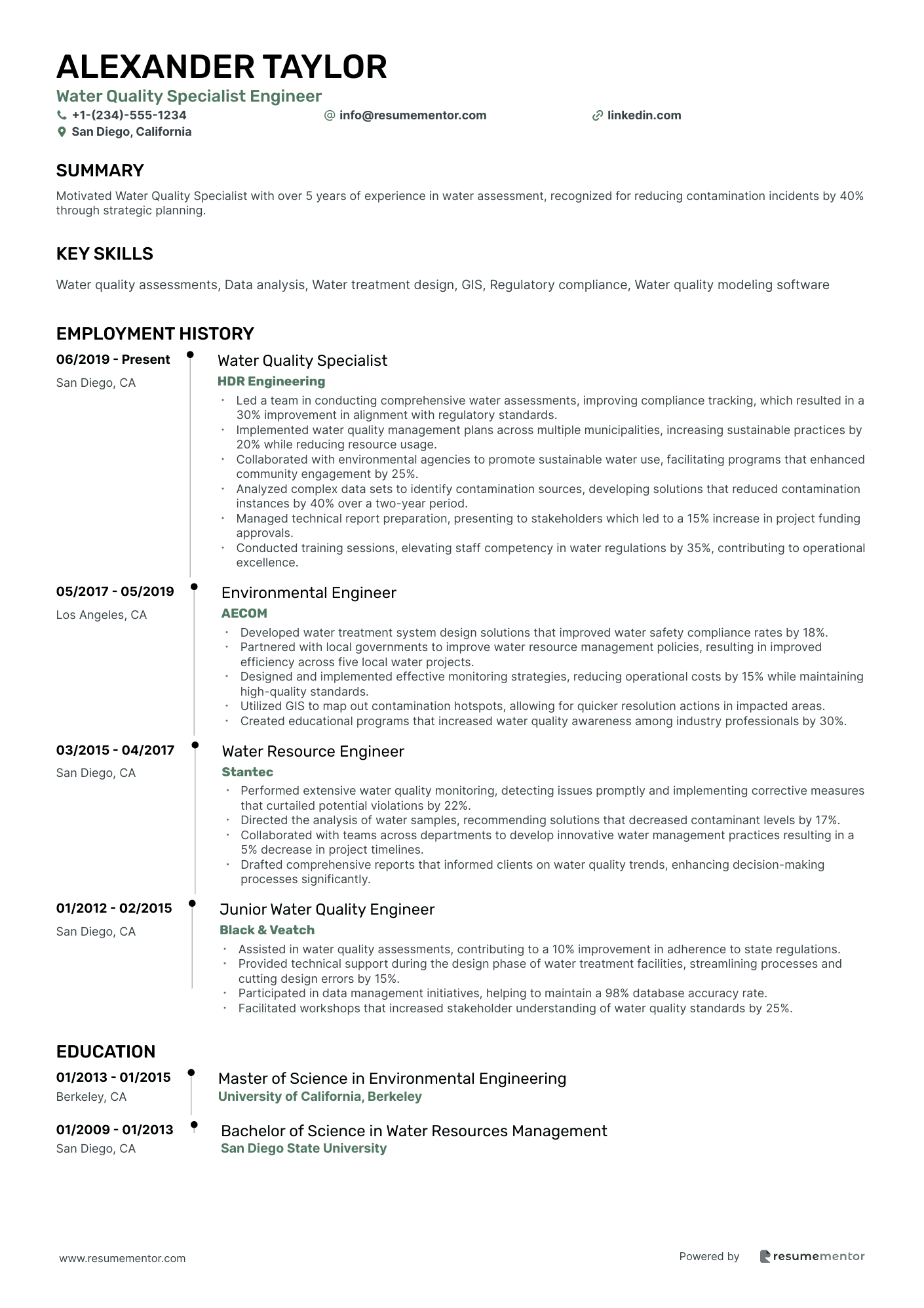
Water Quality Specialist Engineer
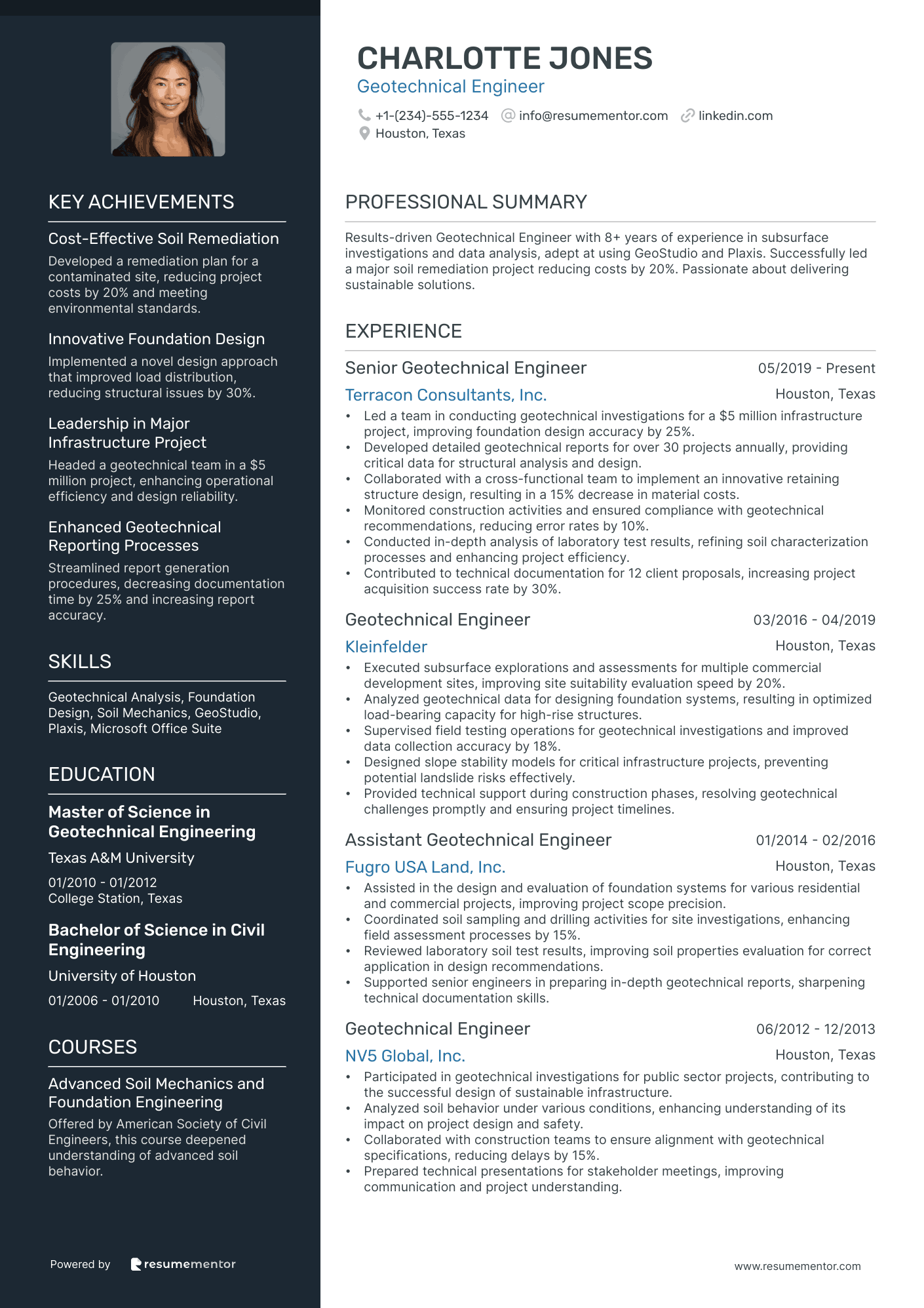
Geotechnical Engineer

Hazardous Materials Removal Engineer
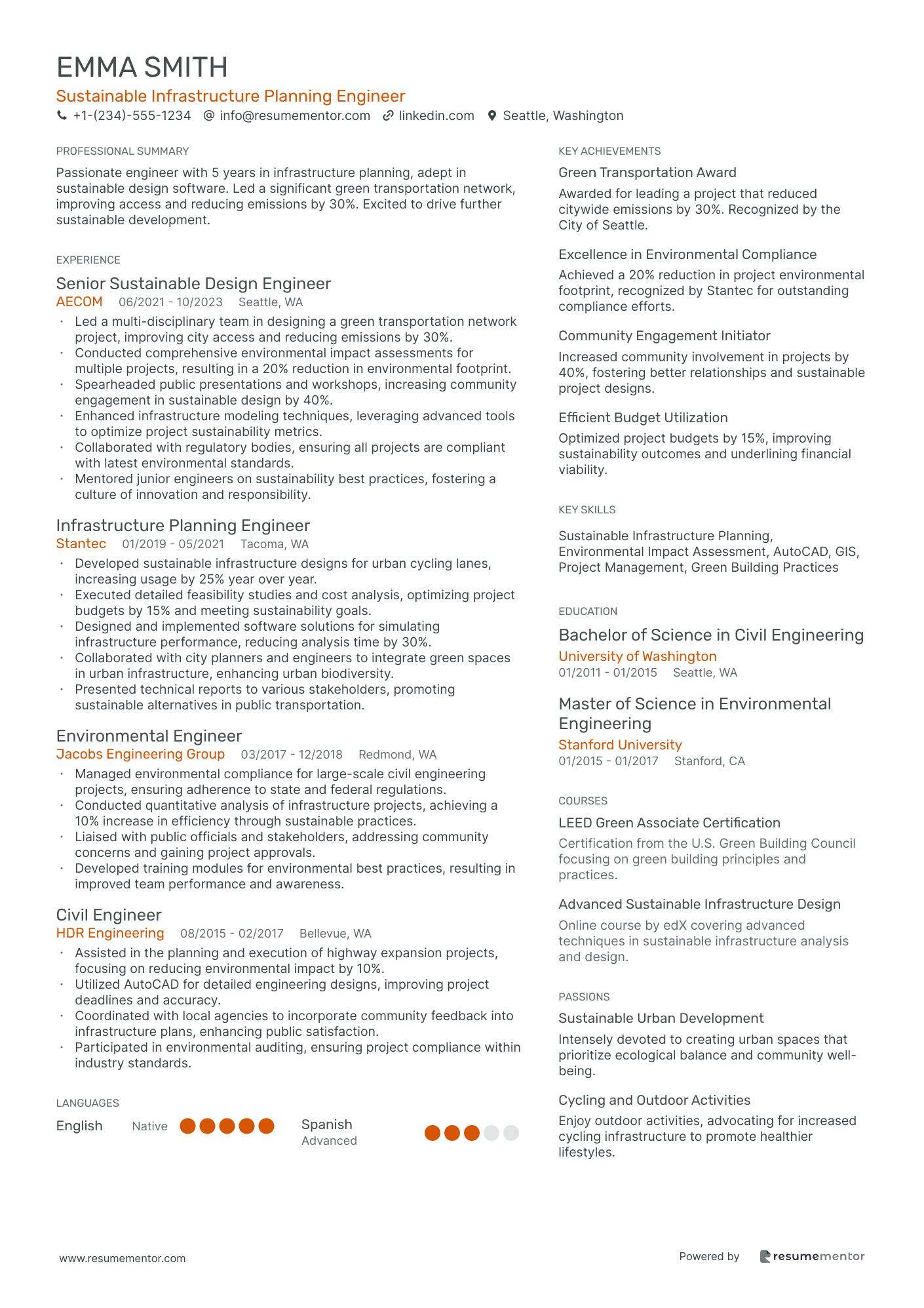
Sustainable Infrastructure Planning Engineer
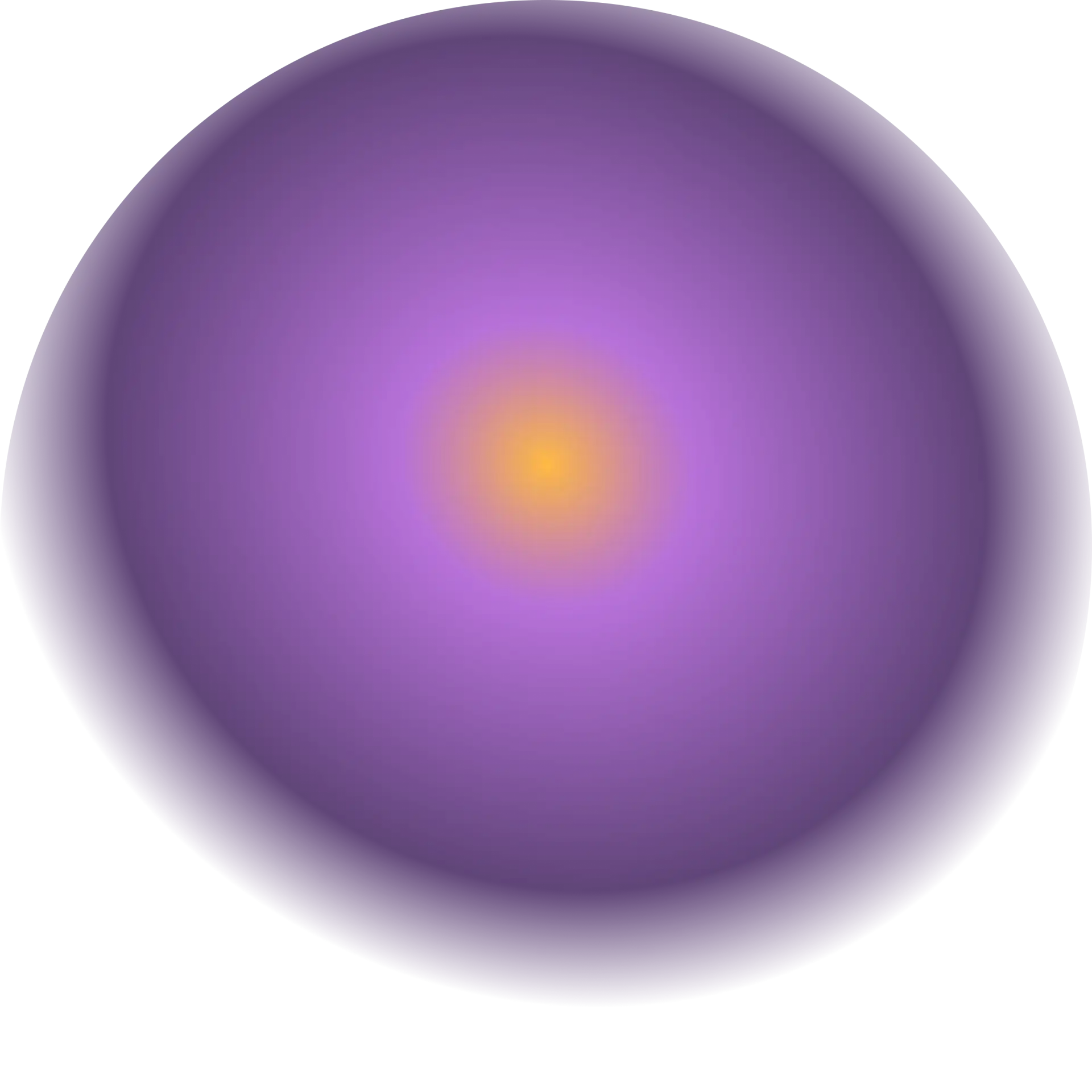
Air Quality Environmental Engineer resume sample
- •Led a team to reduce industrial emissions by 20%, surpassing project goals and improving air quality standards.
- •Conducted over 50 complex air quality assessments, identifying key areas for emissions mitigation across various sectors.
- •Collaborated with regulatory bodies for air quality permits, achieving a 100% approval rate within established timelines.
- •Developed comprehensive air quality modeling for statewide projects, enhancing predictive accuracy of emission forecasts.
- •Implemented monitoring systems that improved data accuracy by 30%, aiding in regulatory reporting and compliance adherence.
- •Presented detailed reports to external stakeholders, leading to enhanced project funding and resource allocation.
- •Prepared and submitted more than 25 compliance reports, aligning projects with stringent environmental standards.
- •Led sustainability initiatives, resulting in a 15% reduction in client operational emissions over two years.
- •Utilized AERMOD to conduct accurate air dispersion modeling, improving the accuracy of environmental impact assessments.
- •Collaborated closely with clients to address diverse regulatory inquiries, reducing processing time by 25%.
- •Developed training modules for junior staff, enhancing department-wide understanding of regulatory compliance processes.
- •Analyzed emission sources from over 15 facilities, implementing controls that resulted in substantial emission reductions.
- •Drafted technical documentation for regulatory agencies, ensuring alignment with federal air quality regulations.
- •Played a key role in the development of innovative air quality monitoring systems, enhancing data collection by 40%.
- •Advised on sustainability policies, including the development of a region-wide greenhouse gas reduction strategy.
- •Contributed to a multi-million dollar emission reduction project, enhancing energy efficiency across municipal facilities.
- •Coordinated with teams to develop predictive models, achieving a 95% accuracy rate in emissions forecasting.
- •Supported the implementation of air quality measures that decreased operational costs by 18% over a three-year period.
- •Engaged in regular client meetings to offer strategic insights, resulting in extended contracts and client retention.
Waste Management Engineer resume sample
- •Led the redesign of waste management systems, reducing processing costs by 20% through efficient waste segregation strategies.
- •Conducted waste audits leading to the implementation of sustainable practices, achieving a 15% increase in material recycling.
- •Collaborated with engineering and environmental teams to integrate waste reduction plans, ensuring alignment with business objectives.
- •Developed comprehensive waste management documentation and compliance reports, speeding approval processes by 30%.
- •Analyzed waste streams and proposed solutions that cut hazardous waste production by 40%, resulting in safer work environments.
- •Delivered training to 50+ employees, increasing awareness and knowledge of eco-friendly waste handling by 90%.
- •Executed waste audits that led to innovative disposal techniques, reducing landfill contributions by 25%.
- •Oversaw performance monitoring of waste programs, refining procedures and boosting efficiency by 18%.
- •Interfaced with regulatory agencies, maintaining compliance and securing yearly permits with zero violations.
- •Developed tech-driven waste data analysis reports, supporting strategic decision-making and regulatory adherence.
- •Spearheaded a cross-functional team project resulting in a 25% reduction in waste disposal costs.
- •Designed waste processing solutions that improved sorting efficiency by 30%, increasing recyclable output.
- •Implemented waste reduction protocols in compliance with environmental standards, enhancing sustainability efforts.
- •Gathered and analyzed waste data, providing actionable insights that supported operational improvements.
- •Prepared detailed waste management strategies, optimizing processes and resulting in better resource allocation.
- •Conducted environmental impact assessments, influencing project designs for reduced ecological footprints.
- •Provided technical support for waste management interventions, promoting sustainable environmental practices.
- •Managed compliance documentation, consistently meeting state and federal regulatory requirements.
- •Supported a project team in enhancing waste management programs, achieving cost savings of over $100,000 annually.
Natural Resource Conservation Engineer resume sample
- •Led a cross-functional team to design a wetland conservation project that improved biodiversity by 40% within two years.
- •Implemented a water management system that reduced water waste by 25% and improved irrigation efficiency in agricultural areas.
- •Developed a soil erosion control strategy that helped decrease soil loss by 30%, resulting in enhanced crop production.
- •Managed environmental impact assessments for 10+ projects yearly, ensuring compliance with state and federal regulations.
- •Improved stakeholder engagement by organizing 15 community education workshops on natural resource management.
- •Trained field staff in the use of GIS software, increasing data analysis accuracy by 20% and reducing response times.
- •Engineered a riverbank stabilization project that decreased flood risk by 35%, protecting nearby communities.
- •Designed cost-effective water conservation systems that saved local municipalities $1.5 million annually in operating costs.
- •Conducted 50+ environmental assessments, balancing conservation needs with community development objectives.
- •Successfully led a project in habitat restoration, resulting in a 20% increase in local wildlife populations.
- •Collaborated with academic institutions on five research projects, advancing the field of ecological engineering.
- •Developed restoration plans for 15 degraded wetland sites, revitalizing ecosystems and improving biodiversity.
- •Assisted regulatory agencies in crafting policies for sustainable resource use, enhancing policy effectiveness by 20%.
- •Oversaw the construction of natural water filtration systems, leading to a 30% improvement in water quality.
- •Contributed to the publication of research papers on innovative soil conservation techniques in top environmental journals.
- •Initiated a soil conservation project that resulted in a 25% reduction in annual soil degradation rates across test sites.
- •Developed GIS models for conservation planning, improving spatial data precision and supporting effective decision-making.
- •Designed urban green spaces that enhanced local air quality, achieving positive public health outcomes and community support.
- •Collaborated with local governments to secure funding for three large-scale conservation initiatives.
Climate Change Analyst Engineer resume sample
- •Led data-driven climate risk assessments for 15 city projects, mitigating environmental impact by 30%.
- •Collaborated with nine cross-functional teams to incorporate engineering solutions, enhancing project sustainability.
- •Prepared detailed reports ensuring compliance with regulatory standards, resulting in reduced operation costs by 12%.
- •Utilized Python and GIS tools to analyze complex datasets, improving accuracy in climate forecasting by 18%.
- •Supported preparation of 8 major funding proposals, securing $2 million in grants for climate initiatives.
- •Engaged community stakeholders in climate change discussions, elevating awareness and resulting in a 15% increase in community project participation.
- •Conducted 20 field assessments, identifying critical climate risks, leading to a 35% improvement in project safety measures.
- •Executed engineering strategies for sustainable resource management, increasing efficiency in water usage by 22%.
- •Compiled and presented findings to senior management, facilitating informed decision-making and project prioritization.
- •Developed in-house modeling tools reducing analysis time by 40%, significantly increasing team productivity.
- •Collaborated with policy analysts on compliance projects, ensuring alignment with new climate regulations and policies.
- •Analyzed climate data sets, contributing to a 28% increase in project accuracy and efficiency.
- •Created visual presentations for public forums, enhancing public understanding of climate impacts.
- •Initiated data management protocols that reduced errors in environmental reporting by 20%.
- •Collaborated with external research teams to support development of new climate models, improving predictive capabilities.
- •Advised corporate clients on sustainable practices, achieving a 15% reduction in energy expenditures.
- •Developed sustainability solutions for infrastructure projects, enhancing environmental performance by 25%.
- •Facilitated workshops on climate issues, leading to increased industry partnership on green initiatives.
- •Supported environmental compliance reporting, ensuring adherence to all relevant regulations and standards.
Environmental Systems Design Engineer resume sample
- •Led a multidisciplinary team to design sustainable systems, achieving a 25% reduction in project costs through innovative solutions.
- •Developed technical specifications for large-scale environmental projects, which improved compliance with regulatory standards by 30%.
- •Executed feasibility studies and environmental impact assessments for urban infrastructure projects, resulting in a 40% enhancement in energy efficiency.
- •Collaborated with stakeholders and regulatory bodies to align project goals with sustainable design practices, enhancing client satisfaction by 15%.
- •Implemented advanced simulation models to optimize system design, improving performance metrics by 20%.
- •Mentored junior engineers, increasing team productivity by 35% through hands-on training and dedicated support.
- •Engineered sustainable solutions for building systems that decreased energy consumption by 18% across multiple projects.
- •Performed detailed technical analyses to ensure compliance with environmental regulations, achieving 100% adherence across all assignments.
- •Actively engaged with clients to communicate system designs, improving client retention rates by 10%.
- •Conducted training workshops on sustainable practices for new engineering staff, resulting in heightened awareness and application.
- •Participated in industry conferences, sharing insights on sustainable design, and influenced emerging best practices.
- •Managed the integration of sustainable systems into existing project designs, leading to a 15% increase in project efficiency.
- •Prepared comprehensive technical documentation and reports, enhancing stakeholder understanding by 60%.
- •Developed environmental design concepts for urban projects that reduced emissions by 10% in pilot implementations.
- •Liaised with regulatory bodies to ensure the swift approval of project proposals, accelerating timelines by 20%.
- •Analyzed and designed environmental systems that improved resource efficiency by 20% across various projects.
- •Created engineering drawings using AutoCAD, which enhanced the clarity and precision of project plans by 25%.
- •Conducted site evaluations to support sustainable design integration, leading to superior project alignment with environmental goals.
- •Developed client presentations to clearly communicate complex environmental design strategies, increasing engagement by 50%.
Environmental Remediation Engineer resume sample
- •Led a team to analyze and remediate contaminated soil in industrial sites, resulting in a 35% decrease in project duration.
- •Implemented innovative bioremediation techniques that improved pollutant breakdown rates by 40%.
- •Developed risk assessment reports aligning with CERCLA guidelines, approved by state regulatory agencies within three months.
- •Collaborated with clients and stakeholders to ensure complete understanding of project goals, leading to a 20% increase in client satisfaction.
- •Utilized GIS to map contamination levels and develop effective remedial action plans, increasing project efficiency by 30%.
- •Managed remediation projects under budget by 25% by optimizing resource allocation and using cost-effective technologies.
- •Conducted site assessments and prepared comprehensive reports that improved remediation time by 20%.
- •Oversaw field activities, ensuring all safety protocols were adhered to, resulting in zero incidents over two years.
- •Assisted in designing landfill capping systems that reduced environmental impact and extended facility lifespans by 15 years.
- •Analyzed environmental monitoring data using AutoCAD and GIS, improving accuracy in predicting contamination spread by 25%.
- •Trained and mentored junior staff, which enhanced team performance by 30%.
- •Coordinated with multidisciplinary teams on projects, achieving compliance with RCRA and reducing project approval time by 20%.
- •Designed groundwater treatment systems that reduced contamination levels by 50% in six months.
- •Prepared technical reports for state environmental agencies, improving report acceptance rates to 95%.
- •Utilized HEC-RAS software to model hydrological impacts, leading to optimized flood management plans.
- •Performed in-depth environmental investigations, which led to a 40% increase in early pollutant detection rates.
- •Developed remediation plans using cutting-edge technologies, reducing cleanup times by 30%.
- •Collaborated with regulators and stakeholders, achieving project milestones 15% faster than standard timelines.
- •Presented project findings at professional conferences, gaining recognition and subsequent industry awards.
Water Quality Specialist Engineer resume sample
- •Led a team in conducting comprehensive water assessments, improving compliance tracking, which resulted in a 30% improvement in alignment with regulatory standards.
- •Implemented water quality management plans across multiple municipalities, increasing sustainable practices by 20% while reducing resource usage.
- •Collaborated with environmental agencies to promote sustainable water use, facilitating programs that enhanced community engagement by 25%.
- •Analyzed complex data sets to identify contamination sources, developing solutions that reduced contamination instances by 40% over a two-year period.
- •Managed technical report preparation, presenting to stakeholders which led to a 15% increase in project funding approvals.
- •Conducted training sessions, elevating staff competency in water regulations by 35%, contributing to operational excellence.
- •Developed water treatment system design solutions that improved water safety compliance rates by 18%.
- •Partnered with local governments to improve water resource management policies, resulting in improved efficiency across five local water projects.
- •Designed and implemented effective monitoring strategies, reducing operational costs by 15% while maintaining high-quality standards.
- •Utilized GIS to map out contamination hotspots, allowing for quicker resolution actions in impacted areas.
- •Created educational programs that increased water quality awareness among industry professionals by 30%.
- •Performed extensive water quality monitoring, detecting issues promptly and implementing corrective measures that curtailed potential violations by 22%.
- •Directed the analysis of water samples, recommending solutions that decreased contaminant levels by 17%.
- •Collaborated with teams across departments to develop innovative water management practices resulting in a 5% decrease in project timelines.
- •Drafted comprehensive reports that informed clients on water quality trends, enhancing decision-making processes significantly.
- •Assisted in water quality assessments, contributing to a 10% improvement in adherence to state regulations.
- •Provided technical support during the design phase of water treatment facilities, streamlining processes and cutting design errors by 15%.
- •Participated in data management initiatives, helping to maintain a 98% database accuracy rate.
- •Facilitated workshops that increased stakeholder understanding of water quality standards by 25%.
Geotechnical Engineer resume sample
- •Led a team in conducting geotechnical investigations for a $5 million infrastructure project, improving foundation design accuracy by 25%.
- •Developed detailed geotechnical reports for over 30 projects annually, providing critical data for structural analysis and design.
- •Collaborated with a cross-functional team to implement an innovative retaining structure design, resulting in a 15% decrease in material costs.
- •Monitored construction activities and ensured compliance with geotechnical recommendations, reducing error rates by 10%.
- •Conducted in-depth analysis of laboratory test results, refining soil characterization processes and enhancing project efficiency.
- •Contributed to technical documentation for 12 client proposals, increasing project acquisition success rate by 30%.
- •Executed subsurface explorations and assessments for multiple commercial development sites, improving site suitability evaluation speed by 20%.
- •Analyzed geotechnical data for designing foundation systems, resulting in optimized load-bearing capacity for high-rise structures.
- •Supervised field testing operations for geotechnical investigations and improved data collection accuracy by 18%.
- •Designed slope stability models for critical infrastructure projects, preventing potential landslide risks effectively.
- •Provided technical support during construction phases, resolving geotechnical challenges promptly and ensuring project timelines.
- •Assisted in the design and evaluation of foundation systems for various residential and commercial projects, improving project scope precision.
- •Coordinated soil sampling and drilling activities for site investigations, enhancing field assessment processes by 15%.
- •Reviewed laboratory soil test results, improving soil properties evaluation for correct application in design recommendations.
- •Supported senior engineers in preparing in-depth geotechnical reports, sharpening technical documentation skills.
- •Participated in geotechnical investigations for public sector projects, contributing to the successful design of sustainable infrastructure.
- •Analyzed soil behavior under various conditions, enhancing understanding of its impact on project design and safety.
- •Collaborated with construction teams to ensure alignment with geotechnical specifications, reducing delays by 15%.
- •Prepared technical presentations for stakeholder meetings, improving communication and project understanding.
Hazardous Materials Removal Engineer resume sample
- •Spearheaded a team of 10 in a large-scale hazardous waste removal project, improving project efficiency by 25% and reducing delays significantly.
- •Developed and optimized removal plans adhering to all regulatory requirements, leading to zero compliance issues and greater client satisfaction.
- •Implemented advanced safety protocols across various sites, reducing safety incidents by 30% over one year.
- •Collaborated with stakeholders and regulatory bodies, ensuring seamless project execution and improved community relations.
- •Authored comprehensive reports and documentation for hazardous materials assessments, which increased documentation accuracy by 20%.
- •Trained and mentored junior engineers in best practices of hazardous material handling, enhancing their operational effectiveness by 15%.
- •Managed compliance for over 100 projects involving hazardous materials, ensuring all federal and state regulations were met with 100% compliance.
- •Developed company-wide environmental training programs, increasing regulatory knowledge among staff by 40%.
- •Led site assessments to identify and mitigate potential risks, contributing to a 20% reduction in environmental violations.
- •Initiated the integration of new materials tracking software, improving project tracking efficiency by 50%.
- •Achieved cost savings of 15% in waste disposal processes through innovative practices and supplier negotiation.
- •Conducted over 200 site inspections, ensuring all hazardous material processes meet stringent safety standards, resulting in zero workplace incidents.
- •Coordinated with cross-functional teams to streamline removal processes, reducing project completion times by two weeks on average.
- •Developed and presented educational workshops on environmental regulations to over 50 clients.
- •Enhanced hazardous material removal techniques, leading to an improvement in efficiency of 10%.
- •Worked on hazardous materials assessment projects, increasing assessment accuracy by 15% through advanced analytical techniques.
- •Implemented personal protective equipment protocols that reduced exposure risks by 25%.
- •Collaborated with project managers to ensure successful completion of environmental report submissions.
- •Facilitated compliance with safety regulations across multiple projects, resulting in a reputation for high safety standards.
Sustainable Infrastructure Planning Engineer resume sample
- •Led a multi-disciplinary team in designing a green transportation network project, improving city access and reducing emissions by 30%.
- •Conducted comprehensive environmental impact assessments for multiple projects, resulting in a 20% reduction in environmental footprint.
- •Spearheaded public presentations and workshops, increasing community engagement in sustainable design by 40%.
- •Enhanced infrastructure modeling techniques, leveraging advanced tools to optimize project sustainability metrics.
- •Collaborated with regulatory bodies, ensuring all projects are compliant with latest environmental standards.
- •Mentored junior engineers on sustainability best practices, fostering a culture of innovation and responsibility.
- •Developed sustainable infrastructure designs for urban cycling lanes, increasing usage by 25% year over year.
- •Executed detailed feasibility studies and cost analysis, optimizing project budgets by 15% and meeting sustainability goals.
- •Designed and implemented software solutions for simulating infrastructure performance, reducing analysis time by 30%.
- •Collaborated with city planners and engineers to integrate green spaces in urban infrastructure, enhancing urban biodiversity.
- •Presented technical reports to various stakeholders, promoting sustainable alternatives in public transportation.
- •Managed environmental compliance for large-scale civil engineering projects, ensuring adherence to state and federal regulations.
- •Conducted quantitative analysis of infrastructure projects, achieving a 10% increase in efficiency through sustainable practices.
- •Liaised with public officials and stakeholders, addressing community concerns and gaining project approvals.
- •Developed training modules for environmental best practices, resulting in improved team performance and awareness.
- •Assisted in the planning and execution of highway expansion projects, focusing on reducing environmental impact by 10%.
- •Utilized AutoCAD for detailed engineering designs, improving project deadlines and accuracy.
- •Coordinated with local agencies to incorporate community feedback into infrastructure plans, enhancing public satisfaction.
- •Participated in environmental auditing, ensuring project compliance within industry standards.
Creating an effective environmental engineer resume can feel like piecing together a complex puzzle, where every skill and experience finds its place. You must fit these into a concise, well-organized document that reflects your technical expertise, from environmental systems to sustainability project management. This translation of expertise into clear, employer-friendly language is your tool for opening doors to new opportunities.
When you tailor your resume to specific job descriptions, you showcase why you’re the perfect fit for the role. It's about clearly communicating your unique blend of skills and experiences to shine in a competitive field. Using a resume template can make this process smoother, helping you organize your thoughts and ensure no detail is overlooked.
With clarity and consistency, your resume becomes more than just a collection of credentials; it becomes a compelling story. Each section should add value, highlighting not just the projects you've completed, but the tangible impacts you've made. This attention to detail paints a picture of your commitment to making the world a better place. Ultimately, your resume isn’t just a list—it’s a narrative of your professional journey, showing how each step has prepared you for your next big challenge as an environmental engineer.
Key Takeaways
- Create a concise and well-organized resume that reflects your technical expertise and tailors to specific job descriptions to showcase your fit for the role.
- Use a reverse chronological format, PDFs, and a professional font to ensure your resume is readable, well-structured, and maintains its design on any device.
- Quantify achievements in the experience section with numbers, use strong action words, align past responsibilities with job requirements, and avoid overly technical language.
- Integrate skills and strengths as keywords to enhance your profile's visibility to resume scanning systems, focusing on relevant technical abilities and soft skills.
- Add extra sections like language skills, hobbies related to the field, volunteer work, and industry-related books to highlight your well-rounded personality and strengthen your resume.
What to focus on when writing your environmental engineer resume
Your environmental engineer resume should effectively showcase your ability to design, assess, and implement solutions for a variety of environmental challenges—emphasizing your track record with successful projects, your expertise in sustainable practices, and your dedication to protecting natural resources through engineering solutions.
How to structure your environmental engineer resume
- Contact Information: Start your resume with your full name, phone number, email address, and LinkedIn profile. A professional email underscores your credibility; your LinkedIn profile can provide additional depth to your professional presence by reflecting more detailed accomplishments and endorsements.
- Professional Summary: This statement captures the essence of your experience and specialization. Highlight your core strengths like air quality management or water resource engineering. This section acts like an elevator pitch, providing recruiters a quick yet compelling introduction of your value and what you bring to the table.
- Skills: List out the most relevant skills that align with the job description, such as environmental impact assessments, regulatory compliance expertise, and proficiency with industry-standard tools like GIS and AutoCAD. These are vital elements that connect your professional summary and work experience, providing a well-rounded picture of your abilities.
- Work Experience: Showcase your practical accomplishments in previous roles, focusing on specific projects and their outcomes. Whether it’s managing pollution mitigation efforts or developing novel sustainable processes, ensure to quantify results where you can. This strengthens the narrative of your skills and professional summary, offering tangible proof of your effectiveness.
- Education: Detail your academic background, emphasizing degrees in environmental engineering or related fields. Highlight certifications like EIT or LEED that complement your experience and skills. This section not only illustrates your foundational knowledge but also integrates with your previous roles and specialized skills.
- Projects/Research: Outline significant projects or research you’ve contributed to, noting your role and the impact of the work on environmental outcomes. This underscores your commitment and capability, reinforcing the narrative built in previous sections.
Exploring these sections in more depth will guide you in crafting a comprehensive resume format, ensuring each piece connects and contributes to a holistic picture of your environmental engineering capabilities and potential impact in future roles.
Which resume format to choose
For an environmental engineer's resume, starting with the right format is crucial because it organizes your information in a way that best highlights your qualifications. A reverse chronological format is often most effective. It places your latest experiences at the forefront, underscoring your ability to apply recent and relevant skills—something highly valued in engineering roles focused on current environmental challenges.
Font choice further contributes to your resume's impact. Opting for modern fonts like Montserrat, Raleway, and Lato can enhance readability and give a polished look. While details about each font are less critical, these options provide a fresh alternative to more conventional fonts, aligning with a professional image.
When it comes to file type, PDFs are always recommended. They maintain your resume’s layout and design, ensuring it appears professional on any device. This consistency is essential when targeting engineering positions, where attention to detail is a must.
Lastly, keeping your margins around one inch helps balance text and white space, creating a document that's clean and easy to navigate. This thoughtful organization reflects well on your skills as an engineer, showing your ability to communicate effectively and present information logically. Balancing these elements will bolster your professionalism in the environmental engineering field.
How to write a quantifiable resume experience section
Crafting an effective environmental engineer resume experience section means connecting your skills and achievements in a cohesive, engaging way. This part of your resume should highlight your background and make your value clear to employers by weaving your career narrative together seamlessly. Start with your most recent job and work backward, covering the last 10-15 years for relevant roles. Choose job titles that align with the positions you’re targeting. Tailor your resume by linking your past responsibilities and successes directly to the job requirements you're pursuing. Use powerful action words like "enhanced," "implemented," and "optimized" to effectively convey your impact, and include numbers to provide concrete examples of your accomplishments.
- •Cut chemical waste by 25% with improved recycling systems, saving $200,000 a year.
- •Boosted energy efficiency by 30% through renewable energy solutions.
- •Led environmental audits resulting in a 15% rise in regulatory compliance.
- •Designed a sustainable water management system with cross-functional teams, reducing water usage by 40%.
The experience section excels by intertwining quantifiable achievements with strong action words, creating a narrative that not only details what you've done but shows how you’ve made impactful changes. By aligning this with industry standards, you ensure that your resume captures employers’ attention, blending your achievements with job requirements in a way that brings your qualifications to life. This approach keeps your resume both engaging and persuasive, making your career story compelling and ensuring your skills and successes are apparent.
Result-Focused resume experience section
A result-focused environmental engineer resume experience section should clearly showcase how your contributions have made a difference. Start by highlighting specific projects where you've had a notable impact, focusing on the results you achieved rather than just listing daily tasks. It's important to use numbers to quantify your successes, like the percentage of money saved or time reduced, as this illustrates the value you brought to your projects.
Tailoring your bullet points to align with the skills and expertise relevant to the jobs you are applying for will make your resume more appealing. Incorporate strong action verbs such as "developed," "implemented," or "coordinated" to convey initiative and responsibility. Avoid using overly technical language that might not be clear to everyone. By making your achievements understandable at a glance, you ensure they stand out to potential employers.
Environmental Engineer
Eco Solutions Inc.
June 2018 - August 2022
- Led a team to redesign a waste management system, bringing down operational costs by 30%.
- Rolled out a new water recycling strategy, resulting in a savings of 1 million gallons of water each year.
- Collaborated with cross-functional teams to create eco-friendly packaging, cutting material use by 15%.
- Conducted environmental impact assessments, boosting compliance with state regulations by 20%.
Achievement-Focused resume experience section
A well-crafted achievement-focused environmental engineer resume experience section should emphasize your most significant contributions with clear, measurable outcomes. Concentrate on how your innovative solutions addressed environmental challenges, led projects, or improved resource efficiency. By highlighting specific metrics and results, you can clearly illustrate the impact of your efforts. This approach makes your achievements stand out and demonstrates the tangible value you bring to potential employers.
Begin each statement with dynamic action verbs to convey your role and the significance of your initiatives. Paint a clear picture of the challenges you faced and the successful solutions you implemented, such as cost reductions, efficiency improvements, or sustainability enhancements. This cohesive narrative effectively showcases your ability to deliver results that matter.
Environmental Engineer
Green Earth Solutions
June 2020 - Present
- Created an innovative waste reduction program, cutting solid waste by 30% in one year.
- Led a team to implement a new wastewater treatment system, boosting processing efficiency by 40%.
- Streamlined energy use in facilities, saving 15% in energy costs annually.
- Designed a community outreach program that boosted stakeholder engagement by 25%.
Innovation-Focused resume experience section
An innovation-focused environmental engineer resume experience section should clearly illustrate how your creative solutions have led to tangible improvements in your projects. Begin by describing the challenges you encountered and the innovative methods you applied to address them. Highlight any technologies or processes that you developed or implemented, as well as the positive outcomes they produced. This effectively showcases your ability to think creatively and contribute significantly to your workplace.
By quantifying your achievements with numbers, percentages, or other relevant data, you provide potential employers with a clear picture of your impact. Emphasize skills that reflect your innovative mindset, such as problem-solving, analytical thinking, and adaptability. Use simple language to explain complex projects, ensuring that each entry highlights the unique value you brought to the organization.
Environmental Engineer
Eco Solutions
June 2019 - July 2022
- Created a new water filtration method that reduced waste by 30%, improving efficiency.
- Led a team to design a sustainable irrigation system, cutting water use by 20%.
- Developed a new material for pollution sensors, increasing accuracy by 15%.
- Collaborated with cross-functional teams to implement a green certification program.
Growth-Focused resume experience section
A growth-focused environmental engineer resume experience section should seamlessly highlight your ability to drive positive change. Showcase tangible results and use specific examples to illustrate your contributions to past projects' successes. Start by detailing your roles, responsibilities, and achievements, using action verbs to maintain clarity and conciseness. Whenever possible, quantify your accomplishments to emphasize metrics like project efficiency or environmental impact, reinforcing your value in the field.
To further enrich your resume, integrate themes of innovation, sustainability, and teamwork. Highlight the solutions you've implemented that have led to improved environmental outcomes or optimized processes. Ensure each bullet point captures a significant contribution, whether that's increasing efficiency, reducing waste, or ensuring compliance with regulations. This approach not only underscores your past achievements but also demonstrates how these experiences equip you to add value in future roles.
Environmental Engineer
GreenTech Innovations
June 2018 - Present
- Led a team to design a waste reduction system that decreased waste by 30% in the plant.
- Developed a water conservation plan saving over 2 million gallons annually.
- Collaborated with a cross-functional team to ensure compliance with new environmental regulations.
- Implemented a new process that reduced energy consumption by 15% without additional cost.
Write your environmental engineer resume summary section
A well-focused environmental engineer resume summary should highlight the unique skills and experiences that make you stand out. It’s about showcasing what makes you valuable to a potential employer. Demonstrating your impact on past projects, like successfully implementing sustainability improvements, can be key. Clearly stating your main strengths is essential. Consider this example:
This summary effectively captures your experience, skills, and notable achievements, creating a compelling picture. For those just beginning their careers, a resume objective might fit better, focusing more on future goals rather than past successes. This contrasts with a summary, which often highlights accomplishments. A resume profile, on the other hand, can combine elements of both, providing a broader view of past achievements and future aspirations. Additionally, a summary of qualifications is straightforward, offering a quick-view list of your top skills and accomplishments. Understanding these nuances helps tailor your resume to best reflect your career journey and objectives.
Listing your environmental engineer skills on your resume
A skills-focused environmental engineer resume should clearly highlight how your abilities benefit the role. It's important to know that your skills can either have their own section or be integrated into other parts of your resume, like your experience or summary. Emphasizing your strengths and soft skills shows how well you connect with others and adapt to different situations. Meanwhile, your hard skills are the specific abilities or knowledge that make you proficient in tools and software relevant to the job.
Incorporating skills and strengths effectively serves as important keywords on your resume. These keywords not only showcase your qualifications but also enhance your profile's visibility with systems that scan resumes. Consider this example of a standalone skills section in JSON format:
Such a list effectively presents relevant skills, making it clear what you offer as an environmental engineer.
Best hard skills to feature on your environmental engineer resume
Hard skills on your resume demonstrate your technical proficiency and your ability to manage specific tasks within the environmental engineering field. By showcasing expertise with tools, software, and methodologies, you communicate your readiness for the role. Consider these 15 in-demand hard skills:
Hard Skills
- Environmental Impact Assessment
- Geographic Information System (GIS)
- Environmental Policy and Regulation
- Soil Sampling and Analysis
- Computational Fluid Dynamics (CFD)
- Renewable Energy Systems Design
- Waste Management Systems
- Hydrology and Hydraulic Modeling
- Environmental Chemistry
- Pollution Control Technologies
- Remediation Technology
- Climate Change Adaptation
- Erosion Control
- Environmental Auditing
- Toxicology Studies
Best soft skills to feature on your environmental engineer resume
Soft skills highlight your ability to work well with teams, communicate effectively, and adapt to varied scenarios, which are crucial for a successful career in environmental engineering. Here are 15 essential soft skills:
These soft skills ensure you present a balanced blend of technical capability and personal effectiveness in your professional profile.
Soft Skills
- Communication
- Team Collaboration
- Critical Thinking
- Problem Solving
- Creativity
- Adaptability
- Leadership
- Conflict Resolution
- Time Management
- Attention to Detail
- Emotional Intelligence
- Initiative
- Negotiation
- Decision Making
- Motivation
How to include your education on your resume
The education section is a vital component of your environmental engineer resume. It highlights the knowledge and skills you've built through your formal education. Tailoring this section to the job you're applying for will increase your chances of standing out. Only include education that is relevant to the position you're targeting to keep your resume focused.
When adding your GPA, consider mentioning it if it is above 3.0 and relevant to your field. Honors such as cum laude can showcase your academic achievements, so note them clearly under your degree details. When listing your degree, always mention the specific qualification, the institution you've attended, and the dates of attendance.
Here's a poor example of an education section:
Here's a well-crafted example:
The second example is effective as it is tailored to an environmental engineer position. It clearly lists a relevant degree and highlights the applicant's academic success with a notable GPA and honors mention. This demonstrates to potential employers that the candidate has a strong foundation in the field and a commitment to excellence.
How to include environmental engineer certificates on your resume
Including a certificates section in your environmental engineer resume is essential. Certifications demonstrate your expertise and commitment to the field. They also help to set you apart from other candidates. Here’s how to add a certificates section effectively: List the name of each certification you have obtained. Include the date you earned each one. Add the issuing organization to provide validity to your credentials. Consider placing the most relevant certification in the header of your resume to immediately capture attention.
For instance, you might write: "John Doe, Certified Environmental Engineer, LEED Accredited Professional". This immediately highlights a key qualification.
Here’s a standalone example:
This example is effective as it features certifications pertinent to environmental engineering. The Certificates section clearly names the certificate, issuer, and hints at the breadth of the skillset. This attention to detail shows dedication and ensures you communicate your qualifications succinctly and professionally.
Extra sections to include on your environmental engineer resume
Crafting a tailored resume is crucial for showcasing your skills and experiences as an environmental engineer. While technical skills and experience form the cornerstone of your resume, including additional sections can set you apart in the job market.
Language section — Highlight language skills to demonstrate your ability to work in diverse environments and with different cultures. Specify your proficiency levels to show potential employers your communication capabilities.
Hobbies and interests section — Share hobbies related to environmental work to reveal your passion for the field. Mention interests that align with the job, like nature photography or hiking, to create a more personal connection.
Volunteer work section — Showcase volunteer work to highlight your commitment to community service and environmental causes. Include specific projects to display your hands-on experience and dedication.
Books section — List industry-related books you've read to showcase your eagerness to learn and stay updated in your field. Mention titles that have influenced your approach to environmental engineering to reflect your knowledge depth.
Adding these sections can demonstrate a well-rounded personality and skillset, making your resume more appealing. They allow employers to see you as an individual, not just a list of qualifications. Tailor each section to the job you’re applying for to maximize impact. This personalization can make you stand out among other candidates and increase your chances of getting hired.
In Conclusion
In conclusion, crafting an outstanding environmental engineer resume is about more than just listing your past roles and skills. It involves creating a compelling narrative that paints a picture of your professional journey and showcases your expertise in an engaging way. By incorporating sections that highlight your education, certifications, and key achievements, you ensure that each part of your resume contributes to a cohesive story that resonates with potential employers. Tailoring your resume for specific job applications enhances your chances of standing out in a competitive field. Including quantifiable achievements and using action-oriented language can demonstrate how your contributions make a difference in your workplace. Highlighting both hard and soft skills shows a balance of technical proficiency and interpersonal abilities, crucial for thriving in diverse work environments. Additionally, by featuring sections like volunteer work, hobbies, or additional certifications, you can reflect your passion for the field and commitment to continuous learning. Remember that the format and presentation of your resume can impact its effectiveness, so aiming for clarity and professionalism is key. This can be achieved by using modern fonts, maintaining consistent layout and style, and opting for digital formats like PDFs. Your resume should ultimately serve as a bridge to your next opportunity, clearly reflecting how your experiences and skills align with your career goals in environmental engineering.
Related Articles

Continue Reading
Check more recommended readings to get the job of your dreams.
Resume
Resources
Tools
© 2025. All rights reserved.
Made with love by people who care.

